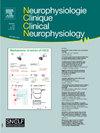The neurophysiology of aggressiveness: From adaptive behavior to pathology and deep brain stimulation
IF 2.4
4区 医学
Q2 CLINICAL NEUROLOGY
Neurophysiologie Clinique/Clinical Neurophysiology
Pub Date : 2025-07-03
DOI:10.1016/j.neucli.2025.103090
引用次数: 0
Abstract
Objectives
Aggressiveness is a complex social behavior that ranges from adaptive to pathological forms. This review synthesizes current knowledge of the neural circuits underlying aggression and explores how this informs neurosurgical strategies for severe, treatment-resistant cases.
Methods
We reviewed recent experimental and clinical studies of the anatomical, functional, and neurochemical bases of aggression, focusing on reactive and proactive subtypes. Emphasis was placed on animal models, optogenetics, and human deep brain stimulation (DBS) approaches.
Results
Internal states – such as hormonal status, energy balance, and prior experience – modulate the threshold for aggression. The ventrolateral part of the ventromedial nucleus of the hypothalamus (VMHvl), particularly its ERα-expressing neurons, plays a central role in triggering aggressive behavior. The core aggression circuit (CAC) includes the VMHvl, amygdala, bed nucleus of the stria terminalis, and ventral premammillary nucleus, under modulation by prefrontal inputs. Aggression is expressed through a direct VMHvl–periaqueductal gray (PAG) pathway for innate actions and an indirect, dopamine-dependent striatal pathway for learned aggression. Serotonin inhibits, while dopamine promotes, proactive aggression.
Discussion
Pathological impulsive aggression, often linked to neurodevelopmental disorders and intellectual disability, may become refractory to pharmacotherapy. In such cases, neurosurgical approaches targeting the Sano triangle—originally described as part of the posterior hypothalamus—have shown promise. Understanding the connectivity and functional role of this region is essential for optimizing targeted interventions. Viewing aggression as a disorder of internal state regulation within defined circuits provides a framework for ethical and effective neuromodulation.
攻击性的神经生理学:从适应性行为到病理学和深部脑刺激
攻击是一种复杂的社会行为,从适应性到病态形式都有。这篇综述综合了目前关于攻击背后的神经回路的知识,并探讨了这如何为严重的、治疗抵抗的病例的神经外科策略提供信息。方法回顾了近年来关于攻击行为的解剖学、功能和神经化学基础的实验和临床研究,重点介绍了反应性和主动性亚型。重点放在动物模型、光遗传学和人类深部脑刺激(DBS)方法上。结果内部状态——如荷尔蒙状态、能量平衡和先前经验——调节攻击的阈值。下丘脑腹内侧核(VMHvl)的腹外侧部分,特别是其表达er α的神经元,在引发攻击行为中起着核心作用。核心攻击回路(CAC)在前额叶输入调制下,包括中脑下丘脑、杏仁核、终纹床核和腹侧乳前核。先天攻击通过直接的vmhv1 -导水管周围灰质(PAG)通路表达,习得攻击通过间接的多巴胺依赖纹状体通路表达。血清素抑制主动攻击,而多巴胺促进主动攻击。病理性冲动攻击通常与神经发育障碍和智力残疾有关,可能对药物治疗难以治愈。在这种情况下,针对萨诺三角(最初被描述为下丘脑后部的一部分)的神经外科方法已经显示出希望。了解该区域的连通性和功能作用对于优化有针对性的干预措施至关重要。将攻击性视为一种内在状态调节的紊乱,这为道德和有效的神经调节提供了一个框架。
本文章由计算机程序翻译,如有差异,请以英文原文为准。
求助全文
约1分钟内获得全文
求助全文
来源期刊
CiteScore
5.20
自引率
3.30%
发文量
55
审稿时长
60 days
期刊介绍:
Neurophysiologie Clinique / Clinical Neurophysiology (NCCN) is the official organ of the French Society of Clinical Neurophysiology (SNCLF). This journal is published 6 times a year, and is aimed at an international readership, with articles written in English. These can take the form of original research papers, comprehensive review articles, viewpoints, short communications, technical notes, editorials or letters to the Editor. The theme is the neurophysiological investigation of central or peripheral nervous system or muscle in healthy humans or patients. The journal focuses on key areas of clinical neurophysiology: electro- or magneto-encephalography, evoked potentials of all modalities, electroneuromyography, sleep, pain, posture, balance, motor control, autonomic nervous system, cognition, invasive and non-invasive neuromodulation, signal processing, bio-engineering, functional imaging.

 求助内容:
求助内容: 应助结果提醒方式:
应助结果提醒方式:


